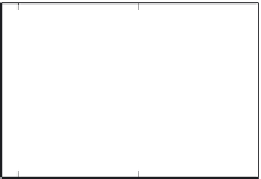Biomedical Engineering Reference
In-Depth Information
× 10
-4
0.15
1
5
Cluster 1
0.1
0
2
-5
0.05
Cluster 2
-10
1000
1500
2000
1000
1500
2000
Wavenumber
Wavenumber
Figure 5.48
Normal: a plot of some of the original spectra (wavenumber cm
−1
) and second-derivative spec-
tra for clusters 1 and 3, bands at ~1000 and ~1200 cm
−1
.
Cluster analysis
Another way to generate false-colour images is through clustering.
K-means or hierarchical clustering can also be used to separate the spec-
tra automatically into a specified number of classes. The example given in
Figure 5.49 compares K-means and hierarchical clustering (Ward's method)
into 2, 3, and 4 clusters.
With two clusters, the methods give fairly similar results and correlate well
with the single-wavelength and PCA images plotted previously. For three
clusters, the results are somewhat different. The mean spectra for each cluster
(Figure 5.50) can also be calculated, which can potentially help with assignment.
A number of researchers have used different protocols to analyse cancer
tissues. Steller et al. [59] used IR microspectroscopic imaging to identify dif-
ferent types of tissue in squamous cell cervical carcinoma samples. Many
images (a total of 122) were collected in absorbance mode from a 10-µm sam-
ple on a CaF
2
slide. They used fuzzy C-means clustering on the full dataset,
then used the cluster centroids (average of all the spectra in a cluster) as
input to an hierarchical clustering algorithm (which would have been too
time-consuming with the full dataset), which they used to generate clusters
equal in number to the number of different types of tissue they expected
(based on light-microscopic analysis of a parallel sample). Their basic goal
was to generate a false-colour image showing the physical structure of the
sample in terms of tissue types. They mention that the long-term goal is to
“calibrate” the method so that it can be used on new samples without the
parallel histological analysis.
Zhang et al. [73] worked with breast-cell suspensions rather than tissue
samples. The suspensions were spread onto BaF
2
plates and measured in
transmission mode. They used PCA (8 factors) for data reduction prior to
K-means clustering (i.e., unsupervised) to divide the image into
cell
and
noncell
regions. They used an ANN to further divide the cells into cancerous
and normal, with partial success. Their spectra looked slightly unusual.











Search WWH ::

Custom Search